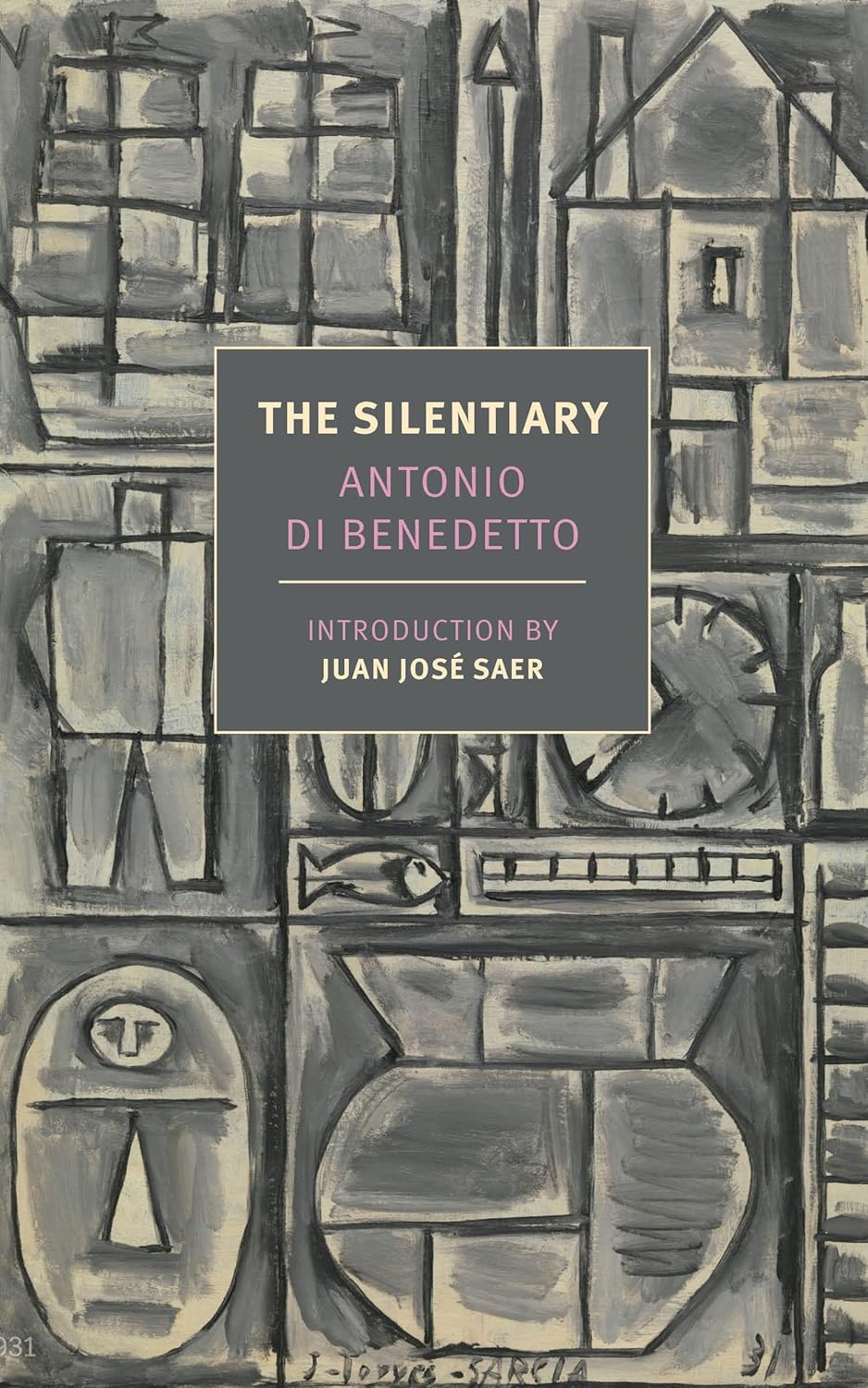


THE NARRATORS of Antonio di Benedetto’s “Trilogy of Expectation” blur further in each successive book, until they are all but effaced. In Zama,published in 1956, the narrator has a name (Don Diego de Zama), a location (the Spanish colony of Paraguay), and several exact dates (we encounter him in 1790, then again in 1794, and finally in 1799). The narrator of the second installment, The Silentiary (1964),is an unnamed clerk in “a Latin American city” sometime in “the late post-war era.” The novel’s setting is precisely imprecise: “the years 1950 and thereafter are plausible,” di Benedetto writes in his introductory salvo. He not only refuses to tell us when and where the book takes place; he tells us that he is not telling us.
The final book in the trilogy, The Suicides (1969), is the most eerily inexact of all. The narrator has no name and no definite setting. He has a job at a newspaper, a long-suffering mother, and a rotating cast of insignificant girlfriends, but his attachments are fragile, and his journalistic endeavors are as weightless as a dream. Attentive readers might infer that he lives in a Latin American city, perhaps in di Benedetto’s native Argentina, probably sometime in the 1960s, but there is no way to be sure. He is so wavering that he could be anyone, anywhere, at any time, if not for the films he sees in the cinema.
The trilogy is itself a tenuous assemblage. The three books that make it up have thematic affinities but no common landmarks or characters, and di Benedetto did not intend for them to constitute a series. Zama’s dedication—“to the victims of expectation”—gave rise to a tentative grouping that emerged after the author’s death in 1986, but it is still not clear that the books belong together. Sometimes, even the writing within each novel seems disparate and unconnected. Di Benedetto indents so zealously that entire paragraphs consist of single sentences or fragments, as though his constructions were dissipating as we read them, or each word were fleeing from the next.
But even if these novels are not quite like each other—and not quite like themselves—they are not quite like anything else, either. The novelist Juan José Saer writes in his introduction to The Silentiary that di Benedetto is “undoubtedly the most original” Argentinian stylist of the twentieth century. He may be overstating the case a little: the earlier stories, with their parade of clever animals, are evident homages to Kafka, and the self-sabotaging characters throughout di Benedetto’s oeuvre bear a certain resemblance to the destructive protagonists in Dostoevsky. But the prose is indeed singularly glancing and elliptical. These hazy books, which refuse to resolve into anything definite, are united and distinguished by the extent of their disunity. They are at odds with everything, even and especially themselves.
DON DIEGO DE ZAMA works as a counselor for the provincial Gobernador, but what this post entails is difficult to discern, because he takes great pains to do anything and everything but his job. Instead of performing his duties, he seethes, nurses grudges, squanders his money, erupts into paroxysms of rage, and lusts after women he does not succeed in courting. Occasionally, he performs the odd bureaucratic task or half-heartedly meets with a petitioner, but his true vocation is resentment. He is an Americano—a white man and an officer of the Spanish crown who was born in Latin America, for which reason he cannot aspire to the promotions or privileges afforded his Spanish-born colleagues. At most, he can hope for a transfer to a more central Latin American city and a reunion with his wife and sons, who remain in a distant part of the viceroyalty. In the meantime, he victimizes his mixed-race and Indigenous subordinates, loses his temper, and waits. “My career was stagnating in a post that was, it had been implied from the start, only a stopgap appointment,” he groans. In the first scene of the book, he spots a monkey corpse floating in the water by the docks without drifting further down the river and immediately identifies himself with it: “There we were: ready to go and not going.”
The narrative, too, is ready to go but not going. It does not proceed so much as spiral, spinning in fits and starts. When we first meet Zama, it is 1790. Then, suddenly, it is four years later, then five years after that. In each section, there are dramatic changes in Zama’s circumstances: the second segment finds him conducting a loveless affair with an impecunious Spanish woman with whom he has a child, and in the final act, he treks into the jungle with a band of soldiers in pursuit of a notorious bandit. But there is never any alteration in his ultimate condition, a stasis that is stifling and unshakable. Even in the end, when he is brutalized and left to die in the forest by the bandit’s henchman, his fundamental state does not change. He hears someone say, “Do you want to live?” and does not respond. Whether he is in the offices of the Gobernador or deep in the jungle, he is listless and ineffectual, ready to go and not going.
The narrator of The Silentiary is not even ready to go. He cannot so much as get out the door: “I open the gate and I meet the noise,” the book begins. The noise in question—that of a bus idling on the street—is bedeviling, and the narrator cannot bear it. He wants to write a novel, but he is too harassed by the sounds that assail him no matter where he goes. Even his house is under siege. There are many offenders: initially, there is only the bus, but soon an auto-repair shop is slated to be built in the neighborhood. “When I walk by, I feel as if someone is vociferating through a megaphone and hurling cascades of screws and bolts at me,” the narrator cries.
His life changes almost as much as Zama’s throughout the course of his resident novel—he marries and has a child, and his eccentric friend goes missing—but nothing really matters to him besides his battle with the racket of the city. He moves from one house to another in an effort to escape it, but the clamor pursues him everywhere. After the dreaded auto-repair shop comes a dance hall, then a farmers’ market. The police refuse to intervene. “There’s nothing to hear,” one of them assures the narrator with maddening insouciance.
But there is always something to hear in a populous city. The only way to achieve absolute quiet is to eliminate the source of the din: humanity itself. “Human beings are generators of sound,” the narrator reflects in desperation. “Other people are sonority.” But even if there were no people left, there would still be the unbearable clatter of a mind in disagreement with itself. “If I’m here with myself, I’m accompanied,” the narrator writes. To eliminate the sound of his own thinking, he, too, would have to die.
Perhaps the insuperable silence of death would be something of a relief. The narrator of The Suicides suspects as much: he sets out to write a series of articles on suicide, prompted by three photographs of people who have killed themselves and whose corpses have strangely placid expressions. “There’s terror in their eyes,” he tells his editor, “but their mouths are grimacing in somber pleasure.” His fascination is personal: both his father and his cousin succumbed to suicide, and his grandfather, he seems to recall, once bragged that there had been a total of twelve suicides in the family (although the narrator wonders, “Did he dream this history? Did I dream he dreamed it?”). Sometimes, suicide strikes the narrator as an assertion—perhaps the only possible assertion—of agency. “Do you have to wait for death, like an elderly retiree, or do you have to do it, the way Papa did?” he thinks.
But in almost none of the cases the narrator investigates did anyone do anything. In this novel, people kill themselves not out of despair but out of apathy, merely because they cannot identify a positive reason to go on living. Two schoolboys who enter into a suicide pact pass notes back and forth to one another: “Yes, I will do it.” “Why?” “And why not?” A woman with whom the narrator embarks on an affair plans to kill herself for “no particular reason. . . . Is there a need for one?” No one here chooses to die: they only stop choosing not to. As Benjamin Kunkel writes in the New Yorker, the narrator is “not so much debating whether to kill himself . . . as waiting to find out whether he will do so.” Perhaps more aptly, he is waiting to find out if suicide is going to happen to him.
Di Benedetto’s characters are violent—Zama in particular is prone to attack his inferiors—and they all display the sort of sexism borne of disregard. The narrator of The Silentiary is tortured by every last clang in the auto-repair shop but is deaf to the crying of his own child, which he leaves his wife to handle. “It ruins her sleep, while I don’t even hear it,” he writes indifferently. The journalist in The Suicides tries to seduce women as if undertaking a science experiment. When one attempt fails, he laments that it did not “produce results.” But even these characters’ worst crimes and cruelties are omissions rather than commissions. Di Benedetto’s narrators cannot take hold of anything, even their own callousness. They falter; they flicker; they do not coalesce.

NOR, IN THE END, did their author. Di Benedetto was born in 1922 in Mendoza, a small city in the foothills of the Andes. Like Kafka, his most obvious influence, he remained in the provinces, far from the literary establishment, for almost all of his life. He would have achieved greater recognition in the capital of Buenos Aires, but instead he went on working as a journalist and a film editor in his hometown until 1976. To be sure, he was not toiling in obscurity: his first collection, Mundo Animal (1952), was awarded a prize by a jury that included none other than Jorge Luis Borges, and he counted some of the biggest names in world literature among his allies and admirers. Still, El Boom, the explosion of Latin American literature onto the international scene in the ’60s and ’70s, passed him by, in part because he remained sequestered in the mountains, in part because his sensibility was more quietly disconcerting than that of his peers. He did not write exuberant family epics, like Gabriel García Márquez, or audacious experiments, like his compatriot Julio Cortázar. Instead, he conjured up nightmarish works of refusal and retreat.
“Caprice plays no role in the construction of his novels. With a sure and skillful hand, his subtle artistry discards all superfluous rhetoric to concentrate on the essential,” writes Saer. But caprice played an enormous role in di Benedetto’s life, if not his art. He was arrested by Argentina’s military dictatorship for no ostensible reason in 1976—he had never been especially political, although he had covered right-wing violence in the course of his work as a journalist—and during the ensuing year and a half of imprisonment, he endured four mock executions. The tortures he weathered were agonizing in their own right, but worst of all was the arbitrariness with which they were meted out. J. M. Coetzee writes in the New York Review of Books that di Benedetto was “bewildered by the brutal prison regime” and spent his days “trying to make sense of the random assaults.” He was released in 1978 at the urging of a number of famous writers, among them Heinrich Böll, but long after he had taken up residence in Madrid he remained haunted by his ordeal. He returned to his native country in 1984, a year after the end of the dictatorship, only to die in 1986.
Although the “Trilogy of Expectation” was completed six years before di Benedetto’s arrest, it is hard to imagine a more prescient meditation on the dizzying senselessness of his suffering. His prose is every bit as deliberate as Saer alleges, but his narrators are flitting and episodic, beholden to distant forces they cannot understand. For Zama, these forces have a name: Spain. For the narrators of The Silentiary and The Suicides, the invisible authorities are more diffuse. They are the sounds and stresses of the city, the ache in the atmosphere, the soporific languor of akrasia.
But whether the architect of their stagnation is an emanation in the air or a colonial administrator in Madrid, di Benedetto’s protagonists do not act—they are acted upon. The trilogy is full of passive constructions and sentences in which the narrators are objects, not subjects. When Zama loses his temper, “the fit returned,” as if his rage were an external imposition, and the narrator of The Silentiary complains, “Noise stalks and harries me.” It is the animal; he is the prey.
When the narrators in the trilogy try to instigate anything, they fail, not only to complete the tasks they have set for themselves, but even to protect the solidity of their own intentions. From one moment to the next, their resolutions dissolve. Zama decides to reject an older woman who writes him an amorous letter and then abruptly accepts her: “A single word of response sufficed: No. I wrote: Sí.” The journalist in The Suicides watches one of his deadlines passing as if it were a ship at sea, musing that perhaps he will submit his piece on time, then declining to write it without explanation. The narrator of The Silentiary skips an engagement and neglects to inform the host without quite understanding his own lethargy: “When I was on my way out last night I was about to let you know but then I lost track, I don’t know why.”
It is only in his fantasies of authorship that he enjoys any intimation of agency: “The creatures I’ve conceived of do what they must do, living out the drama prefigured for them,” he gloats when he sits down to start his novel. “I’ve told them to get moving and they move.” But creatures of his making never get moving, because he is never able to prevail over the noise for long enough to write them into existence. Instead, he unwittingly diagnoses his own condition, both as a casualty of the city’s cacophony and as that most impotent of creatures, a character in a book. He is the one living out the drama prefigured for him: he is the one cowering in expectation of his creator’s demands.
WHAT, THEN, can these “victims of expectation” expect from di Benedetto? The narrator of The Silentiary expects the city to fall silent; the journalist in The Suicides expects to commit suicide (or expects it to befall him). Zama expects a promotion and a transfer. When we first encounter him, he is at the dock, gazing at the dead monkey in the water, expecting something much more immediate: the ship that will bring his wife’s letters.
But all of these characters also expect a grander and more decisive summons. They expect sense to emerge from chaos, agency to emerge from incident. In short, they expect someone or something to mold them into people. “Character! My character! Ha!” cackles Zama after he is caught spying on a group of women bathing in the river. He means, of course, to scoff at his bad behavior—but he also means that he is not cohesive, that he has never managed to integrate himself into a unified actor. He has no character, in either sense of the word.
The three entries in di Benedetto’s shadowy series are disconnected from each other, but only insofar as they are disconnected from everything else, including themselves. If no one commands any internal coherence, if no event follows meaningfully from any other, then there is no reason to divide one book from the next, or to distinguish one person from another. Character! Ha! There is only a sequence of spasms.
But spasms, too, can be expectant. At the end of each novel, they are still waiting to see if scattered outbursts can ever cleave into a self.
Becca Rothfeld is the non-fiction book critic at The Washington Post, an editor at The Point, and the author of the essay collection All Things Are Too Small: Essays in Praise of Excess.
